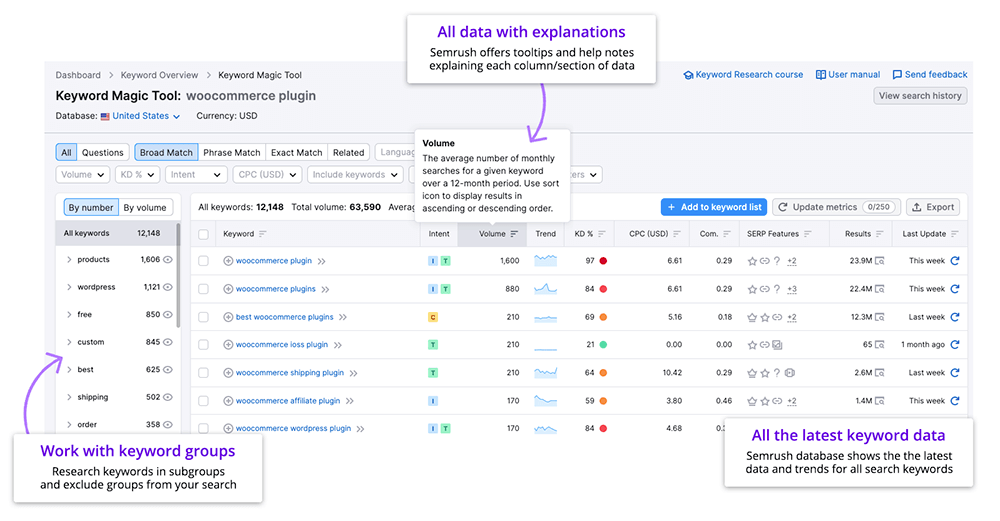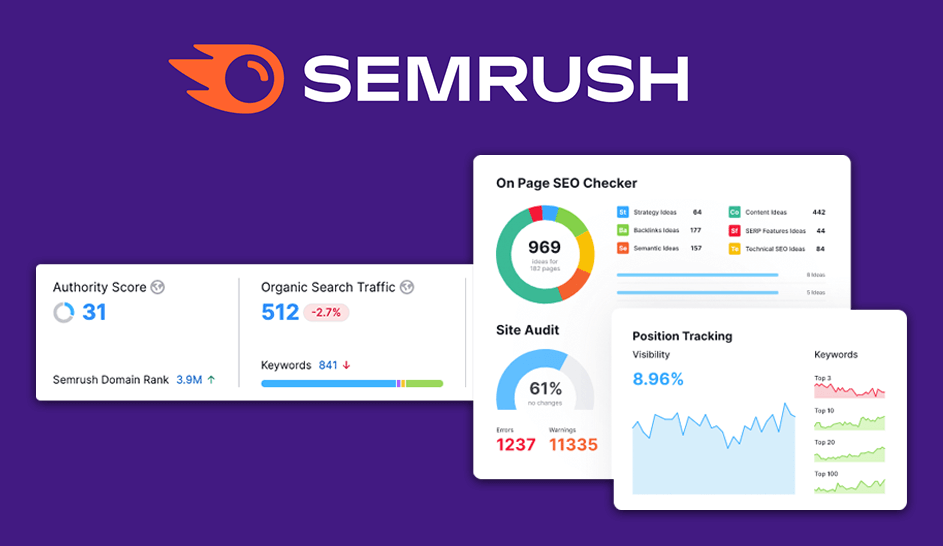What Is Semrush and How Does It Help with SEO?
If you’re new to SEO and trying to figure out how to grow your website traffic, Semrush is one of the most powerful tools you can use these days.
But with so many SEO features, it can feel overwhelming at first.
In this beginner-friendly guide, I’ll walk you through exactly how to use Semrush for SEO… from keyword research and competitor analysis to site audits and traffic tracking.
Whether you’re running a blog, online store, or business website, this step-by-step tutorial will help you get started and make the most of Semrush in 2025.
How to Do Keyword Research Using Semrush (Step-by-Step)
Most people know Semrush for its keyword research tools. While it’s great for many other elements of SEO, understanding its powerful keyword functions will transform your content marketing impact and rankings.
Existing Keyword Rankings
A fantastic place to start is the “Domain Overview” tool which you” find in the left sidebar of the Semrush Dashboard. On the Domain Overview screen you’ll see you can enter your domain name to get started. For an example, we’ll use our StoreCustomizer plugin website to show information on how to use Semrush to improve the website SEO.

Once you’ve entered your domain name, you’ll be presented with a breakdown of many crucial and eye-opening SEO metrics. However, at this stage, you want to look at the Top Organic Keywords results.
This list tells you all the keywords you rank for organically, the position you rank in, the amount of traffic each term receives, the URL that ranks, and much more. You are provided with a lot of information, but if there’s anything you’re unsure of, they do have tooltips and explanations of what each section or feature is.

There are multiple benefits to knowing this information. Firstly, it’s perfect for assessing if your existing SEO campaigns and keyword targeting are working or not.
Furthermore, you should acknowledge the additional data elements, not just keywords. Search intent is crucial for reaching the correct audience. If you have educational and informational articles ranking for commercial or transactional intent keywords, you need to rethink your approach. StoreCustomizer is mostly offering Informational content on the website blog.

Tip: Exclude Your Brand Name
Usually, you’ll find your most popular terms are brand-related keywords. If you’re looking for non-brand long-tail and short-tail keywords, you can use the filtering tools to exclude your brand name or any variations of it.
New Keyword Opportunities
The next stop on our ‘How to use Semrush‘ guide is the Keyword Magic Tool – the Holy Grail for finding impactful keyword opportunities.
There are a few ways you can approach the Keyword Magic Tool, but essentially, it works by typing in a relevant search term and it will return results suggesting other similar keywords.

Again, you’ll find a host of other metrics. The most useful of which are average search volume, keyword difficulty, and search intent. You’re looking to find terms that match the intent of your web page, have an achievable difficulty score, and provide an acceptable amount of traffic.

Your mission is to uncover keywords you aren’t already targeting but should be.
How To Use Semrush for Competitors’ SEO Analysis
The internet is a big place. It’s crammed with websites, businesses, and competitors. You may think you know who your competitors are, but you may be surprised when you follow our next Semrush tips and tricks.
SEO is competition. It’s an ongoing battle between you and your competitors to claim the best ranking spots, whether you’re focusing on SEO for your landing pages, website or online store, you need to keep on top of and take inspiration from their strategy. Semrush helps you do exactly that.
Discover Who Your Competitors Are
Head back to the Domain Overview tool and tap on your website address. Scroll down to Main Organic Competitors and you’ll be presented with 5 competitor domains. Drill into this report, and you’ll find a detailed competitive positioning map and details of all your organic competitors, not just the top 5. You can see which keywords your competitors are getting organic traffic from and lots more information on them.

You can use this list as a base for upcoming competitor research. With Semrush, you’re able to input any domain name into the Domain Overview tool, so now that you know who your competitors are, you can find out which keywords they rank for. This is a great way to find hidden keyword opportunities you may have missed.
Identify Best Performing Competitor Content
Ok, the next Semrush SEO tool we’re going to look at is under the Pages tab. Firstly, enter one of the competitors’ domain names you just uncovered. Then, click the Organic Research tab. Scroll down until you see the Top Pages widget.
This widget details which organic web pages and content are most lucrative for your competitors. What’s great is that Semrush provides data, including the keywords each page ranks for, the backlinks it’s generated, and how much traffic it drives.

You can use this information and take inspiration from their high-performing pages.
Find Backlink Opportunities
Backlinks are one of the most important ranking factors in the Google algorithm. Many businesses ignore this as they have little understanding of how to monitor and generate new backlinks. The Semrush SEO tool empowers users to view backlinks to their own and competitors’ websites, providing insights into potential backlinks to remove or new ones to target.
Head to the Link Building section of the Semrush toolbar, and you’ll see a selection of different options. Here, you’ll see your domain authority, new and lost backlinks, referring domains by authority score, and much more.

With backlinks, your aim is to attract high-authority domains. While this can be challenging, Semrush is a great place to find inspiration. Again, by inserting your competitor’s domain, you can pinpoint potential link-building opportunities. If a high authority domain, or any other website, is linking to a brand with similar products and services to you, it’s likely they’ll link to you too.
Site Audit: How to Check for SEO Issues with Semrush
The Site Audit feature offered by Semrush alone makes the cost of Semrush seem worth it… You can run website audit whenever you add new content or just to ensure your site health is good, meaning there are no (search engine) crawl issues, your site markup, performance and internal linking is all 100% and more.

Simply enter your domain url into the Site Audit section and then wait for Semrush to finish the audit.

Once completed, you’ll be able to view your website score, and thematic reports on everything you can improve on your website from critical errors to site warnings and also simply information improvements you might want to do.
You can click on the list of issues, if any, and Semrush will also explain exactly how to fix them, and why you’d want to fix them to improve your website.

What does Semrush cost?
Semrush offers prices which, for the valuable of information they provide to you, are very reasonable for a freelancer or company to afford.

There are 3 main pricing plans:
Pro Plan – This is for the freelancer or small business. You’re able to manage up to 5 projects and you get the basic SEO, Social media and PPC tools you need for $139.95 per month.
Guru Plan – Manage up to 15 projects and receive all the Pro plan features plus Content Marketing Toolkit, historical data, multi-location and device tracking, GDS integration and more, all for $249.95 per month.
Business Plan – This plan is designed for large agencies or companies managing up to 40 projects. Get all the features of the Pro & Guru plans plus lots more such as PLA analytics, API access, you can extend the limits, get free migration help and more. The business plan goes for $499.95 per month.
You can also contact Semrush for custom plans if you need.
For the freelancer or website owner, the pro plan should be cheap enough for the value and help that Semrush will be providing.
If you’re a small company, you should be able to quite easily cover these costs by charging your clients a retainer for your monthly services on improving their website SEO and search engine rankings.
Final Thoughts: Is Semrush Worth It for Your SEO Strategy?
Knowing how to use Semrush isn’t difficult. With foundational SEO knowledge, you can easily get started with analyzing your own performance, finding keywords, and monitoring competitors.
In this Semrush guide, we’ve only discussed a handful of the amazing SEO tools that Semrush offers. For SEO beginners and experts, it provides the perfect mix of basic and user-friendly tools, as well as in-depth optimization data that anyone can use.
If you’re looking to start an SEO freelance business or a company that offers Search Engine Optimization as a service, the Semrush is a must have product for you as it will give you the data and report you need to impress your clients and give them reassurance that you know exactly what you are doing.
There are some good tutorials on learning how to use Semrush… and when used effectively, it can be transformational to any SEO strategy.
How to Use Semrush for SEO – Answers to the Most Asked Questions
If you’re just getting started with Semrush or still exploring what all Semrush can do, you’re not alone.
Below are some of the most common questions I get asked about using Semrush for SEO. These quick answers will help you understand the basics and get the most out of this powerful tool.
Is Semrush good for beginners?
The short answer… Yes!
Semrush is great for beginners because it offers an intuitive interface and powerful tools that are easy to learn. With features like keyword research, site audits, and traffic analytics, it’s an all-in-one SEO platform that helps new users improve their website visibility.
How do I use Semrush for keyword research?
To use Semrush for keyword research, simply enter a topic or seed keyword into the Keyword Magic Tool.
Semrush will then generate thousands of keyword ideas along with search volume, difficulty score, and intent.
You can then filter and choose keywords that fit your niche and SEO goals.
What are the best Semrush tools for SEO?
Some of the best Semrush tools to help you. master your SEO goals include:
- Keyword Magic Tool for keyword research
- Site Audit Tool to fix technical SEO issues
- Position Tracking to monitor keyword rankings
- Backlink Analytics to analyze link profiles
- SEO Content Template to optimize your content
Can I use Semrush for free?
Yes, Semrush offers a limited free plan that gives access to a few reports per day.
However, to unlock the full range of SEO tools and data, you’ll need a paid plan.
The free version is great for trying out basic keyword and domain research features.
Is Semrush worth it for small businesses or bloggers?
It definitely is!
Semrush helps small businesses and bloggers grow their traffic by revealing the best keywords to target, improving site health, and analyzing competitors.
Using a platform like Semrush is like having a full SEO toolkit in your hands… It can save you time and increase your visibility online.
Conclusion: Using Semrush for SEO
SEO is important… You can either purchase a product like Semrush and try in out yourself for only $120 for 1 month and then decide to keep going on a monthly basis, or you can get an SEO company involved to improve your website for you, but they will most likely charge more, but even more likely, they’ll probably be using Semrush (or something similar) themselves too as it’s the only way to get hold of the data and knowledge that Semrush offer.
I hope this post has helped to explain a little on SEO… Please get in contact if you have any questions.



